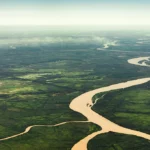Embark on a journey to discover what is the widest river in the world and unravel the mysteries hidden within its vast expanse. The Amazon, a name synonymous with vastness, often claims the title. Yet, the quest to determine the world’s truly widest river is far more nuanced than simply measuring a static waterway. The dynamic nature of rivers, influenced by seasonal variations, tides, and even the very definition of a “river,” presents a fascinating challenge. This exploration delves into the complexities of river width, examining the contenders, the science behind the measurements, and the ecological significance of these watery giants.
The Contenders: A Tale of Two Titans
The Amazon, a colossal river snaking through lush rainforests, often wears the crown of “widest.” During the rainy season, it swells to an impressive 40 kilometers (24 miles)—a distance comparable to crossing a small country. Yet, another contender, the Río de la Plata, challenges this claim with a staggering width of 220 kilometers (137 miles) at its mouth—considerably wider than the English Channel!
This is where the definition of a “river” becomes crucial. The Río de la Plata, formed by the confluence of the Paraná and Uruguay rivers, flows into the Atlantic Ocean. This makes it an estuary—a transition zone where freshwater meets saltwater, blurring the lines between river and bay. Does this hybrid nature disqualify it? The debate continues, underscoring the complexity of crowning a definitive “widest.”
Measuring the Mighty: A Fluid Science
Measuring a river’s width isn’t as simple as it seems. Rivers are dynamic systems, constantly changing with the seasons and tides. Do we measure bank-to-bank during the dry season or include the flooded areas during peak flow? The chosen methodology dramatically impacts the results.
Furthermore, the very edges of a river, especially within an estuary, can be difficult to define. The gradual mixing of fresh and saltwater creates a transitional zone, making precise measurement a challenge. Ongoing research and improved techniques may provide more accurate data in the future, but for now, ambiguity remains.
Beyond Width: Other Measures of Might
While width captivates our imagination, other factors contribute to a river’s overall significance. Discharge, the volume of water flowing through a river channel, is another measure of might. Here, the Amazon reigns supreme, carrying more water than the next seven largest rivers combined. This massive flow supports an incredibly rich ecosystem and influences global climate patterns.
| River | Maximum Width (Approximate) | Notes |
|---|---|---|
| Amazon River | 40 km (24 mi) (wet season) | Commonly cited as the widest; greatest discharge volume; source and length debated. |
| Río de la Plata | 220 km (137 mi) (at mouth) | Classified as an estuary/gulf by some; formed by the confluence of Paraná and Uruguay Rivers; crucial for shipping. |
| Lena River | 2-10 km (1.2-6.2 mi) | Longest river in Russia; significant for agriculture and transportation. Experiences significant seasonal fluctuations. |
| Ob River | Data varies considerably | Significant Siberian river; some data suggests it rivals the Amazon in maximum width during flood stages, requiring further investigation. |
The Widest in the US: A Different Perspective
Shifting our focus to the United States, the question of “widest” takes on another dimension. Alaska’s Yukon River boasts a maximum width exceeding three miles in certain stretches, a testament to the raw power of glacial meltwater. However, the Mississippi River, while not reaching the Yukon’s peak, maintains an impressive average width of approximately two miles at Lake Pepin. This consistent breadth presents a different kind of “widest,” highlighting the importance of considering both maximum and average measurements.
| River | Maximum Width (Approximate) | Notes |
|---|---|---|
| Yukon River | 3+ miles | Widest maximum in the US, found in Alaska; fed by Llewellyn Glacier. |
| Mississippi | Varies, ~2 miles at Lake Pepin | Impressive average width, maximum less clear; important for commerce and transportation. |
| Neuse River | 6 nautical miles | Widest entirely within North Carolina; experiences broadening near the coast. |
Conclusion: More Than Just a Measurement
The quest to determine the world’s widest river reveals a deeper truth: rivers are far more than single data points. Their width, while visually striking, represents only one facet of their complexity. From the Amazon’s immense discharge to the Río de la Plata’s estuarine nature, each river possesses unique characteristics that contribute to its ecological, economic, and cultural significance. This ongoing exploration underscores the dynamic nature of our planet and the importance of appreciating the multifaceted roles rivers play in shaping our world.
- Georgia Platform: A Southern Strategy, 1850s - March 31, 2025
- How many weeks is 40 days: Quick Conversion Guide for Accurate Results - March 31, 2025
- How many feet is 300 meters? 984 Feet: Understand Length Conversions Easily - March 31, 2025
















